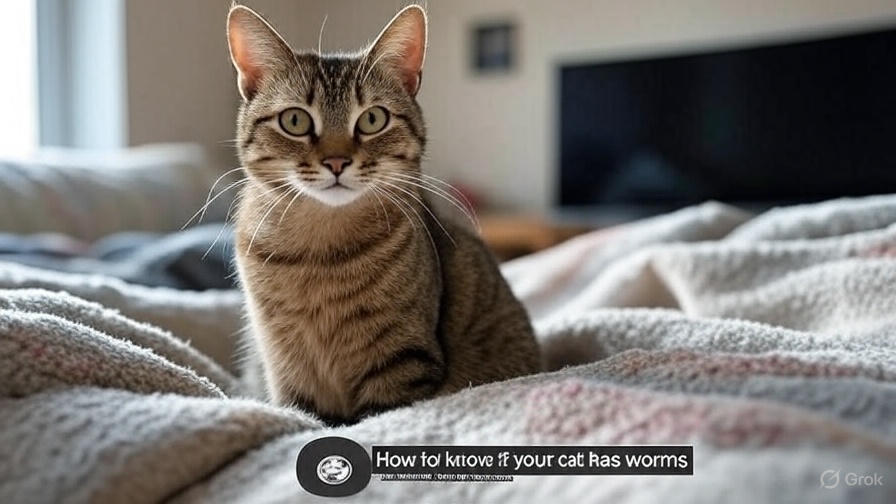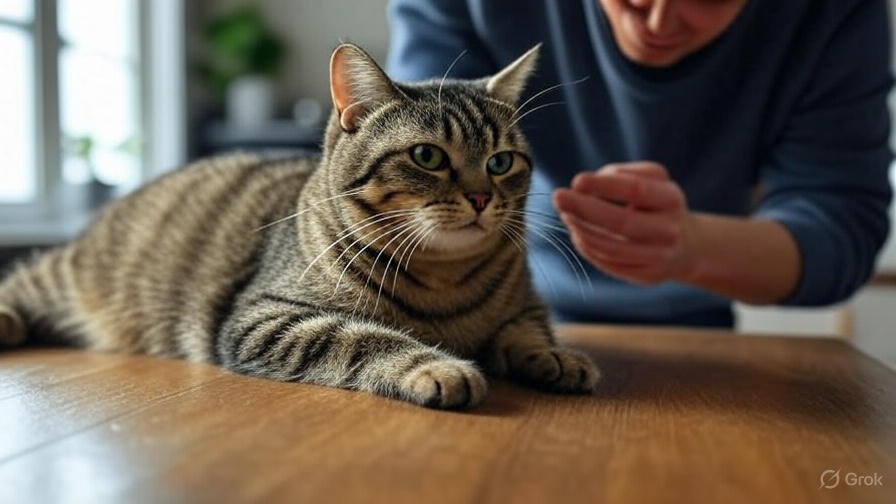How to Know if Your Cat Has Worms?
Cat owners face many health concerns when caring for their feline companions, and intestinal parasites rank among the most common issues. Worms in cats affect millions of pets worldwide, yet many owners struggle to identify the warning signs. This comprehensive guide will help you recognize symptoms, understand different types of parasites, and take appropriate action to protect your cat’s health.
The Hidden Reality of Cat Parasites
Intestinal worms silently invade cats of all ages, from playful kittens to senior felines. These parasites steal nutrients, cause digestive problems, and can lead to serious health complications if left untreated. Indoor cats aren’t immune to these unwelcome guests, as they can contract worms through various unexpected pathways.
Veterinary studies show that up to 45% of cats harbor some form of intestinal parasite during their lifetime. This staggering statistic highlights why every cat owner needs to stay vigilant for signs of worm infestation. Early detection makes treatment more effective and prevents the spread to other pets in your household.
Common Types of Worms That Affect Cats
Different parasite species target cats, each with unique characteristics and symptoms. Roundworms appear as spaghetti-like creatures and represent the most frequent intestinal parasite in felines. These worms can grow up to four inches long and live in the small intestine, where they compete with your cat for nutrients.
Tapeworms create segmented, flat bodies that resemble rice grains when shed in feces. Fleas typically transmit these parasites, making flea control essential for prevention. Hookworms, though smaller than roundworms, cause significant damage by attaching to intestinal walls and feeding on blood.
Whipworms affect the large intestine and cause chronic diarrhea in infected cats. These parasites prove particularly stubborn to eliminate and often require extended treatment protocols. Each worm type demands specific diagnostic methods and treatment approaches.
Visual Signs That Reveal Worm Presence
Your cat’s appearance often provides the first clues about internal parasites. A pot-bellied appearance, especially in younger cats, frequently indicates roundworm infestation. This distended abdomen occurs when worms multiply rapidly and take up significant space in the digestive tract.
Dull, rough coat texture signals that parasites are stealing essential nutrients from your cat’s system. Healthy cats maintain glossy, smooth fur, so noticeable changes in coat quality warrant immediate attention. Weight loss despite normal appetite also suggests worms are consuming nutrients meant for your pet.
Pale gums indicate anemia, which hookworms commonly cause through blood loss. Press gently on your cat’s gums – they should return to pink color quickly after pressure is released. Slow color return or consistently pale gums require urgent veterinary evaluation.
Behavioral Changes That Signal Trouble
Infected cats often display subtle behavioral shifts that observant owners can detect. Increased appetite without weight gain suggests parasites are intercepting nutrients before your cat can absorb them. Some cats develop unusual food cravings or attempt to eat non-food items when worms deprive them of essential nutrients.
Lethargy and decreased activity levels indicate that worms are sapping your cat’s energy reserves. Playful cats may become withdrawn, while social felines might seek more isolated spaces. These personality changes often accompany physical symptoms but can appear independently.
Excessive grooming around the anal area occurs when cats feel irritation from emerging worm segments or eggs. You might notice your cat spending unusual amounts of time cleaning their rear end or scooting across surfaces to relieve discomfort.
Digestive System Warning Signals
Gastrointestinal symptoms provide clear evidence of worm activity in your cat’s system. Diarrhea ranks as one of the most common signs, ranging from slightly loose stools to watery discharge. Blood in the stool indicates more serious parasitic damage and requires immediate veterinary attention.
Vomiting becomes frequent when worm loads reach high levels or when cats have sensitive digestive systems. Adult roundworms sometimes appear in vomit, creating an unmistakable confirmation of infestation. Chronic vomiting leads to dehydration and electrolyte imbalances that compound health problems.
Constipation can occur when large numbers of worms create blockages in the intestinal tract. This symptom appears less frequently than diarrhea but poses serious risks if worms physically obstruct normal waste elimination.
Direct Evidence in Litter Box Deposits
Regular litter box monitoring reveals direct evidence of worm presence. Roundworm eggs remain invisible to the naked eye, but adult worms occasionally appear in fresh feces. These pale, stringy parasites measure several inches long and move slightly when first eliminated.
Tapeworm segments look like small rice grains and may appear dried around your cat’s anus or in sleeping areas. Fresh segments move slightly, while older ones become hard and yellow. These segments contain eggs that contaminate the environment and perpetuate the infestation cycle.
Mucus-covered stools or unusually foul-smelling waste often accompany worm infestations. Healthy cat waste has a distinctive but not overwhelming odor, so significant changes in smell intensity or character deserve investigation.
Secondary Health Complications
Untreated worm infestations trigger cascading health problems that extend beyond digestive issues. Severe anemia develops when hookworms consume significant amounts of blood, leading to weakness, pale membranes, and potentially life-threatening complications in young or elderly cats.
Malnutrition occurs gradually as worms steal proteins, vitamins, and minerals essential for normal body functions. Growing kittens suffer the most severe consequences, experiencing stunted growth, developmental delays, and increased susceptibility to other diseases.
Intestinal blockages represent emergency situations that require immediate surgery. Large roundworm burdens can physically obstruct the digestive tract, preventing normal food passage and waste elimination. Warning signs include persistent vomiting, inability to defecate, and severe abdominal pain.
Risk Factors That Increase Worm Exposure
Certain lifestyle factors elevate your cat’s risk of contracting intestinal parasites. Outdoor access exposes cats to contaminated soil, infected prey animals, and feces from other infected animals. Hunting behavior particularly increases exposure to various parasite species.
Multi-pet households face higher transmission risks, as infected animals can spread parasites through shared litter boxes, grooming behaviors, and environmental contamination. New pet introductions without proper parasite screening can introduce worms to previously clean environments.
Age extremes create vulnerability windows – very young kittens can contract worms through nursing, while senior cats may have weakened immune systems that struggle to control parasite populations. Stress, illness, and certain medications can also compromise natural parasite resistance.

Professional Diagnosis Methods
Veterinary diagnosis relies on multiple testing approaches to identify specific parasite species. Fecal examination under microscopy reveals worm eggs, each type displaying characteristic shapes and sizes. This gold standard test requires fresh stool samples collected within 24 hours.
Some parasites shed eggs inconsistently, necessitating multiple fecal tests over several weeks for accurate diagnosis. False negative results can occur when testing coincides with periods of low egg production or when dealing with single-sex worm populations.
Blood tests detect certain parasites and assess secondary health impacts like anemia or organ damage. Complete blood count results reveal infection-fighting white blood cell changes and red blood cell deficiencies that guide treatment decisions.
Immediate Action Steps for Suspected Infections
When you suspect worm infestation, collect fresh fecal samples for veterinary analysis. Store samples in clean containers and refrigerate until you can transport them to your veterinary clinic. Multiple samples collected on different days improve diagnostic accuracy.
Document symptoms with photos and written descriptions to help your veterinarian understand the full scope of the problem. Record appetite changes, weight loss, behavioral shifts, and any visible parasites you observe.
Isolate infected cats from other pets to prevent transmission while awaiting test results and treatment initiation. Clean litter boxes daily with hot water and disinfectant, and wash your hands thoroughly after handling infected animals or their waste.
Prevention Strategies That Work
Regular veterinary checkups include routine fecal examinations that catch worm infestations before symptoms develop. Annual testing for indoor cats and bi-annual screening for outdoor cats provide adequate monitoring for most situations.
Effective flea control prevents tapeworm transmission, as fleas serve as intermediate hosts for these parasites. Use veterinary-approved flea prevention products year-round, even for indoor cats, since fleas can enter homes on clothing, other pets, or through open doors.
Proper waste management reduces environmental contamination and reinfection risks. Remove feces from litter boxes daily, clean boxes weekly with hot water and disinfectant, and maintain separate boxes for multiple cats when possible.
Treatment Options and Expectations
Modern deworming medications effectively eliminate most common cat parasites with minimal side effects. Your veterinarian will prescribe specific medications based on the identified parasite species, your cat’s age, weight, and overall health status.
Treatment protocols typically require multiple doses spaced several weeks apart to eliminate adult worms and newly hatched larvae. Complete the entire prescribed course even if symptoms improve, as incomplete treatment allows parasite populations to rebound.
Some cats experience mild digestive upset during treatment as dead worms are eliminated from the system. Temporary diarrhea or decreased appetite usually resolves within 24-48 hours and doesn’t indicate treatment failure.
Long-term Health Maintenance
Successful worm elimination requires ongoing vigilance and preventive care. Schedule follow-up fecal examinations 2-4 weeks after treatment completion to confirm parasite eradication. Some resistant parasites may require alternative medications or extended treatment protocols.
Maintain regular parasite prevention routines throughout your cat’s life, adapting protocols based on age, lifestyle changes, and risk factor evolution. Indoor cats that become outdoor cats need more intensive monitoring and prevention strategies.
Environmental cleanup eliminates parasite eggs and larvae that contaminate your home. Steam clean carpets, wash bedding in hot water, and disinfect areas where your cat spends significant time. Some parasite eggs survive in the environment for months, making thorough cleaning essential.
Protecting Your Family’s Health
Several cat parasites can infect humans, making prompt treatment essential for household safety. Children face higher risks due to their play behaviors and less consistent hygiene practices. Pregnant women should avoid handling litter boxes and seek medical evaluation if exposed to infected cats.
Practice good hygiene when caring for infected cats – wear gloves when cleaning litter boxes, wash hands thoroughly after pet contact, and avoid allowing cats to lick faces or hands. These simple precautions dramatically reduce human infection risks.
Regular hand washing, especially before meals and after pet contact, provides your best defense against parasite transmission. Teach children proper hygiene techniques and supervise their interactions with pets during treatment periods.
When to Seek Emergency Care
Certain symptoms require immediate veterinary attention rather than waiting for routine appointments. Severe dehydration, persistent vomiting, bloody diarrhea, or signs of intestinal blockage constitute emergency situations that can rapidly become life-threatening.
Young kittens showing any signs of worm infestation need prompt professional evaluation, as their small size makes them vulnerable to rapid deterioration. Pregnant cats also require careful monitoring and specialized treatment protocols to protect both mother and developing kittens.
Multiple pets showing simultaneous symptoms suggest widespread contamination that requires comprehensive household treatment approaches. Don’t attempt to treat multiple infected animals without professional guidance, as drug interactions and dosing complications can occur.
Conclusion: Vigilance Protects Your Feline Friend
Recognizing worm symptoms in your cat empowers you to take swift action that protects their health and prevents complications. Regular monitoring, prompt veterinary care, and consistent prevention strategies create the best defense against these common parasites.
Remember that early detection always yields better treatment outcomes and reduces the risk of serious health complications. Your cat depends on you to notice subtle changes in their appearance, behavior, and bathroom habits that might signal parasite problems.
Stay informed about worm prevention strategies appropriate for your cat’s lifestyle and risk factors. Work closely with your veterinary team to develop customized prevention protocols that keep your feline companion healthy and parasite-free throughout their life.
The investment in regular parasite screening and prevention pays tremendous dividends in your cat’s long-term health and quality of life. By staying alert to warning signs and maintaining preventive care routines, you’re giving your cat the best possible protection against these unwelcome intestinal invaders.







